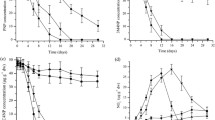Abstract
Changes in microbial populations were evaluated following inoculation of contaminated soil with a 3-chlorobenzoate degrader. Madera sandy loam was amended with 0, 500, or 1000 μg 3-chlorobenzoate g-1 dry soil. Selected microcosms were inoculated with the degrader Comamonas testosteroni BR60. Culturable bacterial degraderswere enumerated on minimal salts media containing 3-chlorobenzoate. Culturableheterotrophic bacteria were enumerated on R2A. Isolated degraders were grouped by enterobacterial repetitive intergenic consensus sequence-polymerase chain reaction fingerprints and identified based on 16S ribosomal-DNA sequences. Bioaugmentation increased the rate of degradation at both levels of 3-chlorobenzoate. In both the 500 and 1000 μg 3-chlorobenzoate g-1 dry soil inoculated microcosms, degradersincreased from the initial inoculum and decreased following degradation of 3-CB.Inoculation delayed the development of indigenous 3-chlorobenzoate degrading populations. It is unclear if inoculation altered the composition of indigenous degrader populations. In the uninoculated soil, degraders increased from undetectable levels to 6.6 × 107 colony-forming-units g-1 dry soil in the 500 μg 3-chlorobenzoate g-1 dry soil microcosms, but none were detected in the 1000 μg 3-chlorobenzoate g-1 dry soil microcosms. Degraders isolated from uninoculated soil were identified as one of two distinct Burkholderia species.In the uninoculated soil, numbers of culturable heterotrophic bacteria initially decreased following addition of 1000 μg 3-chlorobenzoate g-1 dry soil. Inoculation with C. testosteroni reduced this negative impact on culturable bacterial numbers. The results indicate that bioaugmentation may not only increase the rate of 3-chlorobenzoate degradation but also reduce the deleterious effects of 3-chlorbenzoate on indigenous soil microbial populations.
Similar content being viewed by others
References
Alexander M (1999) Inoculation. In: Biodegradation and bioremediation, 2nd ed. (pp 299–323). Academic Press, Inc., San Diego, CA
Altshul SF,Gish W,Miller W,Meyers EW &Lipman DJ (1990) Basic local alignment search tool. J. Mol. Biol. 215: 403-410
Barriault D andSylvestre M (1993) Factors affecting PCB degradation by an implanted bacterial strain in soil microcosms. Can. J. Microbiol. 39: 594-602
Brendecke JW,Axelson RD &Pepper IL (1993) Soil microbial activity as an indicator of soil fertility; the long term effects of municipal sewage sludge on an arid soil. Soil Biol. Biochem. 25: 751-758
Di Giovanni GD,Neilson JW,Pepper IL &Sinclair NA (1996) Gene transfer of Alcaligenes eutrophus JMP134 plasmid pJP4 to indigenous soil recipients. Appl. Environ. Microbiol. 62: 2521-2526
Don RH,Weightman AJ,Knackmuss H-J &Timmis KN (1985) Transposon mutagenesis and cloning analysis of the pathways for degradation of 2,4-dichlorophenoxyacetic acid and 3-chlorobenzoate in Alcaligenes eutrophus JMP134(pJP4). J. Bacteriol. 161: 85-90
Fulthorpe RR,Rhodes AN &Tiedje JM (1998) High levels of endemicity of 3-chlorobenzoate-degrading soil bacteria. Appl. Environ. Microbiol. 64: 1620-1627
Fulthorpe RR &Wyndham RC (1992) Involvement of a chlorobenzoate-catabolic transposon, Tn5271, in community adaptation to chlorobiphenyl, chloroaniline, and 2,4-dichlorophenoxyacetic acid in a freshwater ecosystem. Appl. Environ. Microbiol. 58: 314-325
Krooneman J,Sliekers AO,Pedro Gomes TM,Forney LJ &Gottshcal JC (2000) Characterization of 3-chlorobenzoate degrading aerobic bacteria isolated under various environmental conditions. FEMS Microbiol. Ecol. 32: 53-59
Nakatsu CH,Providenti M &Wyndham RC (1997) The cis-diol dehydrogenase cbaC gene of Tn5271 is required for growth on 3-chlorobenzoate but not 3,4-dichlorobenozate. Gene 196: 209-218
Newby DT,Gentry TJ &Pepper IL (2000a) Comparison of 2,4-dichlorophenoxyacetic acid degradation and plasmid transfer in soil resulting from bioaugmentation with two different pJP4 donors. Appl. Environ. Microbiol. 66: 3399-3407
Newby DT,Josephson KL &Pepper IL (2000b) Detection and characterization of plasmid pJP4 transfer to indigenous soil bacteria. Appl. Environ. Microbiol. 66: 290-296
Ogawa N &Miyashita K (1995) Recombination of a 3-chlorobenzoate catabolic plasmid from Alcaligenes eutrophus NH9 mediated by direct repeat elements. Appl. Environ. Microbiol. 61: 3788-3795
Rodriguez RL &Tait RC (1983) Recombinant DNA techniques: an introduction (pp 160-162). The Benjamin-Cummings Publishing Co., Inc., Menlo Park, CA
Siciliano SD &Germida JJ (1998) Degradation of chlorinated benzoic acid mixtures by plant-bacterial associations. Environ. Toxicol. Chem. 17: 728-733
Versalovic J,Koeuth T &Lupski JR (1991) Distribution of repetitive DNA sequences in eubacteria and application to fingerprinting of bacterial genomes. Nuclei Acids Res. 19: 6823-6831
Wyndham RC (1986) Evolved aniline catabolism in Acinetobacter calcoaceticus during continuous culture of river water. Appl. Environ. Microbiol. 51: 781-789
Wyndham RC,Singh RK &Straus NA (1988) Catabolic instability, plasmid gene deletion and recombination in Alcaligenes sp. BR60. Arch. Microbiol. 150: 237-243
Author information
Authors and Affiliations
Rights and permissions
About this article
Cite this article
Gentry, T.J., Newby, D.T., Josephson, K.L. et al. Soil microbial population dynamics following bioaugmentation with a 3-chlorobenzoate-degrading bacterial culture. Biodegradation 12, 349–357 (2001). https://doi.org/10.1023/A:1014394709703
Issue Date:
DOI: https://doi.org/10.1023/A:1014394709703




